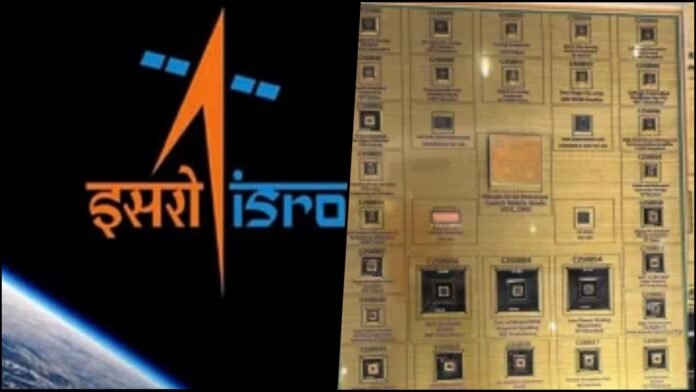
Key Points:
- Historic presentation: PM Modi received India’s first fully indigenous VIKRAM3201 32-bit space processor at Semicon India 2025 on September 2nd
- ISRO-SCL collaboration: Developed by Vikram Sarabhai Space Centre in partnership with Semiconductor Laboratory Chandigarh using 180nm CMOS technology
- Space-grade durability: Designed to withstand extreme temperatures (-55°C to +125°C), radiation, and vibrations for launch vehicles and satellites
- Generational leap: Advanced upgrade from VIKRAM1601 16-bit processor that has powered ISRO missions since 2009
- Domestic production: First production lots delivered in March 2025, marking India’s entry into indigenous space-grade semiconductor manufacturing
- Multi-sector applications: Beyond space missions, chip targets defense, aerospace, automotive, and energy industries
- Strategic importance: Part of India’s ₹76,000 crore semiconductor mission to reduce dependency on imported chips and achieve technological self-reliance
New Delhi: India achieved a defining moment in its technological independence journey as Union Electronics and IT Minister Ashwini Vaishnaw presented the country’s first fully indigenous 32-bit microprocessor, VIKRAM3201, to Prime Minister Narendra Modi at the Semicon India 2025 conference on September 2nd.
Revolutionary Space-Grade Technology
The VIKRAM3201 represents a quantum leap in India’s semiconductor capabilities, developed through collaboration between ISRO’s Vikram Sarabhai Space Centre and the Semiconductor Laboratory (SCL) in Chandigarh. This space-grade processor is engineered to withstand the harshest environmental conditions, including temperature ranges from -55°C to +125°C, intense radiation, and severe vibrations typical of rocket launches and long-duration space missions.
Unlike commercial processors found in everyday devices, the VIKRAM3201 features custom instruction set architecture, floating-point computation capabilities, and support for high-level programming languages like Ada. All associated software tools, including compilers, assemblers, linkers, and simulators, have been developed entirely in-house by ISRO, with work underway on a C compiler to expand application flexibility.
Manufacturing Excellence at SCL Chandigarh
The processor’s fabrication and packaging took place at SCL’s 180nm CMOS facility in Punjab, making it a truly “Make-in-India” space-grade processor. The first production lots were officially delivered in March 2025 during a ceremony where MeitY Secretary S. Krishnan handed over the processors to ISRO Chairman Dr. V. Narayanan.
This achievement builds upon India’s earlier success with the VIKRAM1601 16-bit processor, which has been powering ISRO’s launch vehicles since 2009 and was indigenized in 2016 following the establishment of SCL’s semiconductor fabrication facility.
Technical Superiority and Mission-Critical Performance
The VIKRAM3201’s architecture enables it to process 32 bits of data simultaneously, manage large memory blocks, and execute complex guidance and navigation commands critical for satellites and launch vehicles. The processor underwent rigorous testing, including successful validation during the PSLV-C60 mission, proving its reliability for future space applications.
Technical specifications include:
- 32-bit data processing capability with enhanced computational power
- Military-grade manufacturing standards for extreme reliability
- Radiation-hardened design for space environment compatibility
- Custom floating-point unit for precise calculations
- Advanced memory management for complex mission operations
Alongside VIKRAM3201, ISRO has also developed KALPANA3201, a 32-bit SPARC V8 RISC microprocessor, further expanding India’s indigenous processor portfolio and demonstrating the country’s growing semiconductor design expertise.
Strategic Impact on India’s Semiconductor Mission
Minister Vaishnaw emphasized the rapid transformation of India’s semiconductor landscape, stating: “Just a few years ago, we met for the first time to make a new beginning driven by our Prime Minister’s farsighted vision, we launched the India Semiconductor Mission. In a short span of 3.5 years, we have the world looking at India with confidence”.
The presentation ceremony highlighted India’s accelerated progress under the Semiconductor Mission launched in 2021. Construction of five semiconductor fabrication units is currently underway, with one pilot line completed and two additional units expected to begin production in coming months.
Economic Growth and Global Positioning
The semiconductor achievement comes amid India’s remarkable electronics sector expansion, with production increasing sixfold and exports rising eightfold over the past decade. India now hosts approximately 20% of the world’s chip design engineers, with global firms including Qualcomm, Intel, Nvidia, Broadcom, and MediaTek operating major R&D centers in Bengaluru, Hyderabad, and Noida.
The Semicon India Programme under ISM 1.0 offers incentives worth approximately ₹76,000 crore to attract global manufacturers, positioning India as a stable investment destination amid global policy turbulence.
Multi-Sector Applications and Future Prospects
Beyond space applications, the VIKRAM3201 opens possibilities for deployment across defense, aerospace, automotive, and energy systems – all sectors demanding rugged, high-reliability computing solutions. This versatility positions the processor as a cornerstone technology for India’s broader industrial digitization efforts.
The successful development and production of VIKRAM3201 demonstrates India’s capability to design, manufacture, and deploy complex semiconductor solutions domestically, reducing dependency on imported chips while building strategic technological capabilities.
Global Recognition and Future Vision
Vaishnaw positioned India as “a beacon of progress and stability” in uncertain global times, highlighting the country’s transparent policies and supportive investment environment. The minister urged global investors to recognize India’s emergence as a trusted player in the semiconductor field, emphasizing the nation’s commitment to building comprehensive manufacturing capabilities.
The unveiling of VIKRAM3201 represents more than technological achievement – it symbolizes India’s transformation from a major chip consumer to an emerging semiconductor producer, marking a critical milestone in the country’s journey toward technological self-reliance and strategic independence in the global semiconductor value chain.
As India continues expanding its semiconductor ecosystem, the success of VIKRAM3201 establishes a foundation for more advanced processor development, potentially positioning the country as a significant player in the global space-grade electronics market while strengthening national security through reduced technological dependencies.












































